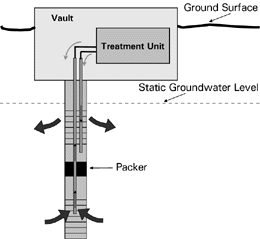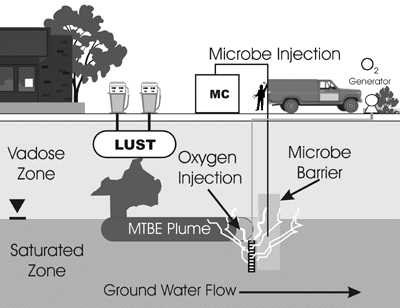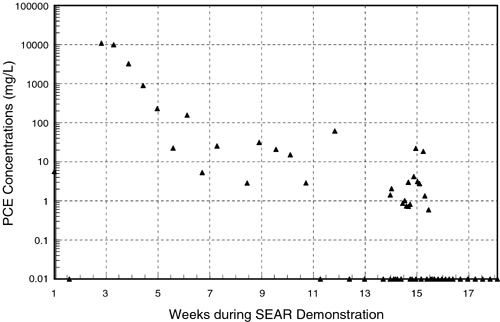|
Ground Water Currents, October 2001, Issue No. 41ContentsGCWs Used with Air Stripping and UV Technologies to Remove TCE and RDX Bioaugmentation Field Testing for MTBE Treatment Surfactant Flooding Used to Remove PCE DNAPL GCWs Used with Air Stripping and UV Technologies to Remove TCE and RDXby Tom Graff, U.S. Army Corps of Engineers, and Curt Elmore, Ph.D., University of Missouri-Rolla In March 2001, the U.S. Army Corps of Engineers completed pilot studies on a dual system for using ground-water circulation wells (GCWs) equipped with an in-well air stripper system to treat trichloroethylene (TCE) and an ultra-violet (UV) light treatment unit to destroy cyclotrimethylenetrinitramine (RDX). After nine months of operation at the former Nebraska Ordnance Plant (NOP) site near Mead, NE, the systems have demonstrated mass removal rates greater than 96 percent. This project marks the first known applications of GCWs involving shallow-tray air stripping technology to remove TCE and UV technology to destroy explosives. Currently used by the University of Nebraska’s Agricultural Research and Development Center and the National Guard, the pilot study sites contain ground water contaminated from past U.S. Department of Defense activities. The underlying Todd Valley and Platte River aquifers are relatively prolific, with the capability of sustaining large-capacity irrigation wells producing 700 or more gallons per minute (gpm). The highest concentrations of TCE and RDX occur in sand and gravel portions of the aquifers, while the bedrock portions have very limited areas of contamination. The depth to ground water at the site is typically 30-40 feet below ground surface (bgs), and the depth to bedrock is typically 100 feet bgs. The dual treatment system used at the NOP site comprises two GCWs equipped with treatment units in partially buried vaults. One of the GCW treatment systems contains a shallow-tray air stripping unit for TCE removal, while the second contains a UV photolysis unit for RDX destruction. Contaminated ground water is pumped into a GCW, treated in the vault, and returned to the aquifer through a separate portion of the same well (Figure 1). A packer is installed midway between the zone of aquifer extraction and zone of recharge to separate the extraction and recharge well screens.
After treatment and recharge to the aquifer, some of the treated ground water travels downstream and away from the GCW influence, while some mixes with untreated ground water and re-enters the GCW for another treatment. Sixteen monitoring wells are used to obtain analytical data at the TCE study area, while ten are used at the RDX area. Field analytical techniques are used for process monitoring, with some samples sent to fixed off-site laboratories for confirmation. The air stripping system uses a 12-inch well to extract ground water from the aquifer at 60-70 feet bgs, at a rate of 50 gpm. TCE concentrations at the point of extraction average 7,000 µg/L, but after a single pass through the shallow-tray air stripper the concentration drops to an average of 110 µg/L at the point of system exit (89-108 feet bgs). Designed slightly differently, the UV system uses a 6-inch well to extract ground water at 50-60 feet bgs and at a rate of 21 gpm. After passing through the treatment vault holding a UV contactor, RDX concentrations averaging 70 µg/L in the extraction zone are reduced to non-detect levels in the recharge zone at 14-40 feet bgs. The widespread impacts of these treatment systems on ground water were estimated using ground-water models and subsequently verified using data from downgradient monitoring wells, which showed significant TCE and RDX concentration reductions. It was estimated that the treatment zone width in the aquifer was approximately 180 feet. This GCW system provides several benefits over the alternative pump and treat system for ground-water remediation at the NOP site. (1) Treated ground water is conserved through recharge to the aquifer, thereby gaining public acceptance. (2) Fewer pipelines are required, so the real estate acquisition costs are reduced. (3) Large masses of contaminants can be removed quickly, with downstream hydraulic containment wells providing safeguards against contamination of clean areas. Full-scale construction costs for the systems are similar (approximately $1.9 million each), but it is estimated that the GCW system costs over 50 percent less for operation and maintenance (approximately $44,000 annually) and will require 50 percent less restoration time than would pump and treat methods. Full-scale application of the dual system using 12 additional circulation wells will begin in early 2002. For more information, contact Tom Graff (U.S. Army Corps of Engineers/Kansas City District) at 816-983-3351 or e-mail Thomas.Graff@nwk02.usace.army.mil. Bioaugmentation Field Testing for MTBE Treatmentby Gerard Spinnler, Ph.D., Equilon Enterprises LLC, Paul C. Johnson, Ph.D., Arizona State University, and Karen Miller, Naval Facilities Engineering Service Center In situ biostimulation and bioaugmentation field tests were conducted at the U.S. Navy’s Hydrocarbon National Environmental Test Site at Port Hueneme, CA, where a dissolved MTBE (methyl tert-butyl ether) ground-water plume extends for more than 1,500 meters. Comparative tests were designed to assess the efficacy of creating an MTBE biobarrier by inoculating the aquifer with a bacterial consortium and maintaining well-oxygenated conditions. The results indicated that MTBE cleanup levels were achieved significantly faster through a process combining both oxygen and microbial injection than through either oxygenation alone or naturally-occurring biodegradation. During 1984-1985, approximately 10,000 gallons of gasoline containing MTBE and 1,2-dichloroethane were released from fuel delivery lines of a leaking underground storage tank (LUST) at Port Hueneme. The area’s uppermost aquifer, which was the focus of this study, consisted of an upper clayey-silt (fill) unit from 0 to 3 meters below ground surface (bgs), and a fine- to medium-grained sand unit from 3 to 6 meters bgs underlain by a competent clay layer at 6 meters bgs. Low concentrations of dissolved oxygen (less than 2 mg/L) within and outside the plume inhibit the potential for natural biodegradation of MTBE. Tests were conducted in three experimental plots to compare MTBE concentrations in treatment areas receiving: (1) intermittent oxygen (O2) injection (biostimulation) only, (2) biostimulation and inoculation with specialized MTBE-degrading microbes (MC-100™) (bioaugmentation), and (3) no treatment (control). Each test plot contained a 6- by 15-meter cell aligned parallel to the estimated ground-water flow. A total of 188 monitoring wells were installed upgradient and downgradient of the cells at depths ranging from 3 to 6 meters. In the two treatment areas, 96 O2 delivery wells also were installed. Oxygenation was achieved by periodic O2 injection directly into the aquifer (Figure 2). Periodic pulsing provides more than adequate dissolved oxygen to the local subsurface environment and minimizes hydraulic conductivity reduction possible with continuous sparging. About 1,700 liters of O2 were delivered to each test cell 4-8 times each day. Within 44 days of beginning the series of gas injections, well-oxygenated zones extending 3 meters upgradient and downgradient of the test cells were established.
The ether-metabolizing bacterial culture used in the field test was grown from an MTBE-enriched activated sludge culture for three to four months at ambient outdoor temperatures. An open-ended, direct-push rod and grout pump assembly were used to inject the culture into the aquifer under pressure at several points along a 6.1-meter transect perpendicular to the ground-water flow and vertically at 2.7-6.1 meters bgs. Microbial solutions were delivered at pressures of 10-100 pounds per square inch across the cell transect in 20-liter injections spaced 0.3 meters apart. A one-time injection of approximately 6,000 liters of solution was conducted. Data indicated that MTBE removal by volatilization was negligible due to the short duration of oxygen pulses. Initial MTBE concentrations of 2-9 mg/L decreased in the O2-only plot to 0.01-0.1 mg/L after a lag period of 186-261 days. In contrast, MTBE concentrations decreased significantly within 30 days of seeding with the microbial injection and throughout the three-year test period, eventually reaching less than 0.001-0.01 mg/L. In the seeded plot, less spatial variability in concentrations was found than in the O2-only area, and no decrease in MTBE-degrading activity has been identified throughout three years of operation. Data indicated that the combined biostimulation/bioaugmentation technology degraded MTBE at least five times faster than did the naturally occurring bacteria in the ground water. Because of the success of these initial bioaugmentation test plots in reducing MTBE concentrations, a 150-meter pilot biobarrier system was installed across the entire width of the Port Hueneme plume in an area of mixed MTBE and BTEX (benzene, toluene, ethylbenzene, and xylenes) in the summer of 2000. Results after seven months of operation have demonstrated dramatic reductions of MTBE from approximately 10 mg/L upgradient of the biobarrier to less that 0.005 mg/L immediately downgradient of the biobarrier. Similar results were observed in BTEX concentrations. For more information, contact Karen Miller (Naval Facilities Engineering Service Center) at 805-982-1010 or e-mail millerkd@nfesc.navy.mil, or Gerard Spinnler (Equilon Enterprises LLC) at 281-544-7319 or e-mail gespinnler@equilontech.com. Surfactant Flooding Used to Remove PCE DNAPLby Laura Yeh, Naval Facilities Engineering Service Center, Leland Vane, U.S. EPA National Risk Management Research Laboratory, and Frederick Holzmer, Duke Engineering & Services A demonstration of surfactant-enhanced aquifer remediation (SEAR) was conducted at Camp Lejeune, NC, to validate SEAR field results for the remediation of sites contaminated with dense non-aqueous phase liquids (DNAPL). The project also was designed to evaluate the feasibility and cost benefit of surfactant regeneration and reuse during SEAR, based on three scales of operation. Demonstration results indicated that 72 percent of the DNAPL was removed from the treatment zone. Associated costs for the use of SEAR were found to be dependent upon permeability conditions and scales of application. The demonstration site contained approximately 100 cubic yards of soil contaminated with perchloroethylene (PCE) DNAPL that was released over the years from a central dry-cleaning facility on the base. The DNAPL zone is located below the facility in a low permeability, heterogeneous shallow aquifer at a depth of about 16-20 feet below ground surface. Permeability decreases downward through the sequential layers from fine sand to silt and clayey silt. The permeability in the fine sand and silty layers, which contain the free-phase and residual DNAPL targeted in the demonstration, was estimated to be in the range of 5 x 10-4 cm/sec to 5 x 10-5 cm/sec. The initial partitioning interwell tracer test (PITT) estimated that the average DNAPL saturation was approximately 4 percent near the facility, decreasing to about 0.4 percent 15-20 feet away from the building. The initial PITT estimated a DNAPL volume of 81 ± 7 gallons, which was confirmed later to be an underestimate by approximately 30 percent as a result of the strong permeability contrast. The demonstration comprised an 8-day pre-SEAR water flood and a 58-day surfactant flood, followed by a 74-day water flood in a 20- by 30-foot well field. The custom surfactant that was used, Alfoterra 145 4-PO sulfate™, was developed to meet the dual objectives of high PCE solubilization (Figure 3) and favorable properties for recovery and reuse of the surfactant. Low flow rates of injection and extraction (0.4 gallons per minute and 1 gallon per minute, respectively) were used to accommodate the site’s low permeability.
Extraction well effluent was treated using two membrane-based processes to remove the contaminant and reconcentrate the surfactant for reinjection. The pervaporation process removed 99.94 percent of the PCE from the effluent prior to surfactant breakthrough, and 95.8 percent during periods of peak surfactant concentrations. The micellar enhanced ultrafiltration process concentrated surfactant in the extraction well effluent from 1.1 to 5 percent by weight, slightly above the reinjection concentration of 4 percent. Recovered surfactant was reinjected into the contaminated aquifer for the final 20 days of the surfactant flood. [Additional information on the pervaporation process, which is a surface treatment process for removing volatile organic compounds from suspended micelles without creating foam, is available from Leland Vane (U.S. EPA National Risk Management Research Laboratory) at 513-569-7799.] A total of 76 gallons of PCE was recovered from the upper, more permeable fine-grained sand layer of the aquifer, but the low-permeability basal silt layer was found to be relatively unaffected by the surfactant flood. Approximately 29 gallons of DNAPL remain within the basal silt layer. Over a 70-day operation period, approximately 3,500 pounds of surfactant were recovered, of which about one-half was reinjected into the aquifer. Cost estimates were prepared for implementing SEAR in a heterogeneous shallow aquifer with an order of magnitude permeability contrast (based on the Camp Lejeune site, but assuming conventional wastewater treatment costs) for full-scale scenarios involving three sizes of DNAPL source zones: approximately 3,000 square feet (0.07 acre), 0.5 acres, and 1.0 acre. Full-scale SEAR costs for the three site sizes ranged from approximately $1.4 million to $12.2 million. Recognizing that SEAR costs are a function of permeability, researchers estimated additional parallel full-scale costs under high permeability conditions (0.01 to 0.001 cm/sec) with all other parameters similar to Camp Lejeune. This cost analysis showed that implementing SEAR under high permeability conditions costs only one- to two-thirds that of SEAR under low permeability conditions. In addition, a cost benefit analysis of surfactant recovery at Camp Lejeune suggested marginal benefits (no more than 3 percent of the total project costs) for the given site conditions. As the first field application of surfactant recycling in the U.S., this demonstration indicates that additional technical improvements are required for surfactant regeneration to be economically viable. Results also indicate that technical improvements are required for SEAR to be economically viable at shallow, low permeability sites such as this. Comprehensive details of the SEAR cost analysis are included in the Final Cost and Performance Report for Surfactant-Enhanced DNAPL Removal (Battelle/Duke, 2001) that will be available in early 2002 on the ESTCP Web site, www.estcp.org. Conducted under the U.S. Department of Defense’s Environmental Security Technology Certification Program, this demonstration serves as one of seven models sponsored by the U.S. as part of the North Atlantic Treaty Organization’s Committee on the Challenges of Modern Society [described in the September 2001 issue of Tech Trends]. For more information, contact Laura Yeh (Naval Facilities Engineering Service Center) at 1-888-484-3372 or e-mail help@nfesc.navy.mil.
|










